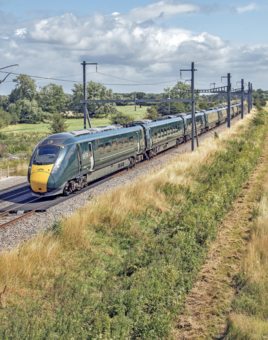EDF is also in negotiation with the Government on a further nuclear power station, Sizewell C in Suffolk, which would be a direct replica of Hinkley Point C.
Spence says: “We’re hoping to see legislation later this year which would be a tangible sign of whether Sizewell C can go ahead. That would add another 3GW of capacity which would help bolster the UK’s energy security. The question of whether there’s more nuclear to follow the Sizewell C project - be it smaller modular reactors or other projects at Wylfa in Wales, in Cumbria or at Bradwell - is for the Government to decide.”
Where electrification isn’t an option, then battery-operated trains could be the answer. There are already examples of battery-powered trains in countries such as Austria and Japan, mainly running on small branch lines.
However, there is always going to be a trade-off between how much the batteries weigh and how much space on the train they take up.
Solutions include having more charging points, perhaps at the end of each branch line or even at each station. It sounds like an ideal solution, but the more chargers you have the more costly it becomes.
There is also the issue of power supply. Most branch lines are in rural areas where the distribution network might not be up to the job, particularly where a rapid charge is required. The faster the charge, the more power that’s needed.
One solution being looked at by Warwickshire-based Vivarail is building a charging system based around a shipping container packed with batteries that can be charged up, perhaps over a 24-hour period and even from a domestic supply if that’s all that’s available.
Vivarail Chairman Adrian Shooter says: “We spent a year going through the Network Rail approval process and our ‘Fastcharge’ system is now about to start on a year’s trial.
“The plan is to test it on a very short and undemanding branch line from West Ealing to Greenford, and that’s happening during 2022.”
Vivarail has already supplied five diesel/battery hybrid trains to the Welsh Government that can run up to 40 miles on battery. The company is also working on a prototype train for the COP26 climate change conference in Glasgow later in the year, which could be capable of up to 100 miles under battery power.
In another sustainable twist to the story, the shipping containers could be filled with old electric car batteries that would effectively be recycled once they’re no longer usable on the road.
Trials are also taking place on Merseyside, where one of the new Stadler Class 777 trains has been fitted with battery technology for use on Merseyrail’s Northern Line. There trains are travelling up to 20 miles per run without needing to be recharged.
Network Rail is also considering the use of battery-powered trains for the 24-mile Lewes-Uckfield line in East Sussex. Its reopening plans could involve either battery propulsion or an extension of the third rail DC system.
Doughty explains: “Twenty-four miles is probably on the limit of what we believe is achievable, although battery technology is improving all the time. Even a battery train solution will require enhancement to the existing traction supply to provide sufficient capacity for charging.”
Interestingly, unlike the project on Merseyside, plans for the Uckfield line could include either static charging at either end or on-the-move charging with short stretches of track being electrified.
EDF is also going into battery technology. In 2019, it acquired a startup company called Pivot Power, which owns several well-placed sites on the electrical transmission network where it has been installing banks of batteries to store electricity - primarily to help keep the network running during times of high demand. But the same technology can also be used for electric vehicle charging where the network isn’t strong enough to allow it.
Spence explains: “The first of these facilities that’s up and running is in Oxford, and it’s called the Energy Super-hub. We are essentially running a wire around the Oxford Ring Road, and that also means we can help with charging at park and ride sites without the local distribution operator having to put in lots of extra sub-stations, which would be much more expensive.”
Could this be the answer to bringing down the cost of getting power to the railways in hard-to-serve areas?












